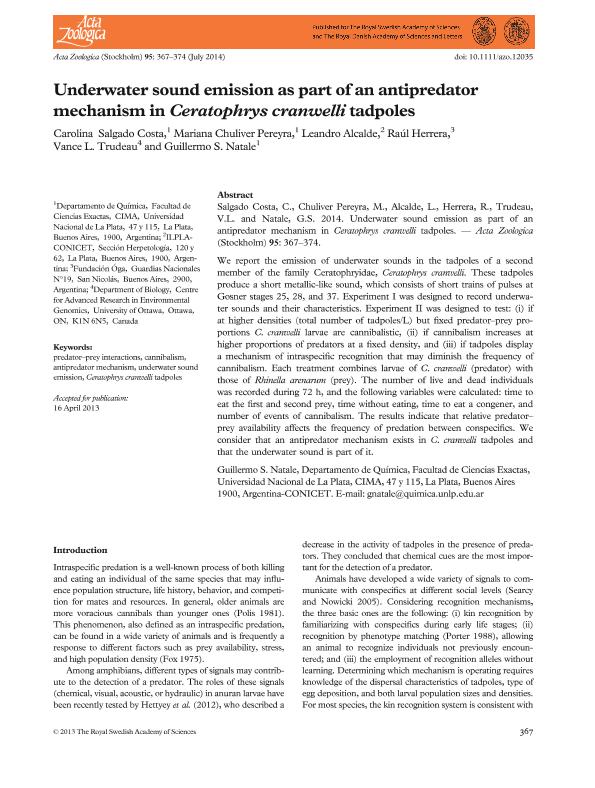Artículo
Underwater sound emission as part of an antipredator mechanism in Ceratophrys cranwelli tadpoles
Salgado Costa, Carolina ; Chuliver Pereyra, Mariana
; Chuliver Pereyra, Mariana ; Alcalde, Leandro
; Alcalde, Leandro ; Herrera, Raúl; Trudeau, Vance L.; Natale, Guillermo Sebastian
; Herrera, Raúl; Trudeau, Vance L.; Natale, Guillermo Sebastian
 ; Chuliver Pereyra, Mariana
; Chuliver Pereyra, Mariana ; Alcalde, Leandro
; Alcalde, Leandro ; Herrera, Raúl; Trudeau, Vance L.; Natale, Guillermo Sebastian
; Herrera, Raúl; Trudeau, Vance L.; Natale, Guillermo Sebastian
Fecha de publicación:
07/2014
Editorial:
Wiley Blackwell Publishing, Inc
Revista:
Acta Zoologica
ISSN:
0001-7272
Idioma:
Inglés
Tipo de recurso:
Artículo publicado
Clasificación temática:
Resumen
We report the emission of underwater sounds in the tadpoles of a second member of the family Ceratophryidae, Ceratophrys cranwelli. These tadpoles produce a short metallic-like sound, which consists of short trains of pulses at Gosner stages 25, 28, and 37. Experiment I was designed to record underwater sounds and their characteristics. Experiment II was designed to test: (i) if at higher densities (total number of tadpoles/L) but fixed predator-prey proportions C. cranwelli larvae are cannibalistic, (ii) if cannibalism increases at higher proportions of predators at a fixed density, and (iii) if tadpoles display a mechanism of intraspecific recognition that may diminish the frequency of cannibalism. Each treatment combines larvae of C. cranwelli (predator) with those of Rhinella arenarum (prey). The number of live and dead individuals was recorded during 72 h, and the following variables were calculated: time to eat the first and second prey, time without eating, time to eat a congener, and number of events of cannibalism. The results indicate that relative predator prey availability affects the frequency of predation between conspecifics. We consider that an antipredator mechanism exists in C. cranwelli tadpoles and that the underwater sound is part of it.
Archivos asociados
Licencia
Identificadores
Colecciones
Articulos(IBIGEO)
Articulos de INST.DE BIO Y GEOCIENCIAS DEL NOA
Articulos de INST.DE BIO Y GEOCIENCIAS DEL NOA
Articulos(ILPLA)
Articulos de INST.DE LIMNOLOGIA "DR. RAUL A. RINGUELET"
Articulos de INST.DE LIMNOLOGIA "DR. RAUL A. RINGUELET"
Citación
Salgado Costa, Carolina; Chuliver Pereyra, Mariana; Alcalde, Leandro; Herrera, Raúl; Trudeau, Vance L.; et al.; Underwater sound emission as part of an antipredator mechanism in Ceratophrys cranwelli tadpoles; Wiley Blackwell Publishing, Inc; Acta Zoologica; 95; 3; 7-2014; 367-374
Compartir
Altmétricas



